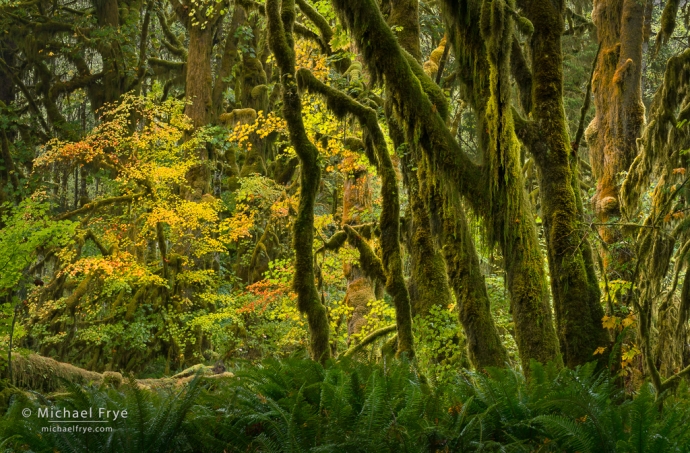Composition
by Michael Frye | Oct 13, 2024 | Composition, Light and Weather

Misty sunrise from Tunnel View, Yosemite NP, California. Where does your eye go in this photograph? Here the brightest areas are in the middle of the image, while the edges are darker, helping to draw the eye into the picture, rather than out of the frame.
We launched our first online workshop about composition about 18 months ago, and then more recently added additional online workshops focused on light. I picked these topics because I think they are, hands down, the two most important aspects of photography.
In photography, nothing is more fundamental than light. When we press the shutter, we record the light falling on the film or sensor at that moment. Light is literally the medium we’re working with, and the quality of the light has everything to do with the mood and message of the photograph.
(more…)
by Michael Frye | Dec 20, 2023 | Composition, Light and Weather

Redwood, maple, firs, and sunbeams, northern California
We had a long, lingering autumn here on the west coast – especially in the Pacific Northwest. On our way up to Oregon in early November, Claudia and I stopped in some redwood groves to check on the fall color. And we found lots of it. It seemed like a good year for color throughout the Northwest, including the far northern corner of California where the biggest redwoods grow. Underneath the redwood canopy, vine maples and big-leaf maples – the same species found on the Olympic Peninsula, and throughout much of Oregon and Washington – can add splashes of color to the forest.
I had long wanted to photograph fall color in the redwoods, but it’s difficult to find the right conditions, especially since the best groves are a nine-hour drive from home. Some years the big-leaf maples just turn brown. And even if they do turn yellow the timing is highly variable. So we felt very lucky to find some good color this year.
(more…)
by Michael Frye | Oct 29, 2023 | Composition, Travels and Stories

Vine maples and big-leaf maples, autumn, Olympic NP, Washington
Earlier this month, Claudia and I spent about two weeks on the Olympic Peninsula in Washington. Part of that time I was co-leading a workshop for Visionary Wild with Jerry Dodrill, which was super fun. We had a great, lively group of people, and beautiful conditions, with lots of fall color, and a gorgeous sunset on the beach.
This was our second trip to the Olympic Peninsula this year, and we loved both visits. There’s something about temperate rain forests that seems to strike a chord with me, whether on the Olympic Peninsula, in the redwoods, or on the west coast of New Zealand.
(more…)
by Michael Frye | Sep 3, 2023 | Composition

Ripples and reflections in an alpine lake, Inyo NF, California. 227mm, 1/125 sec. at f/22, ISO 1250.
During our Range of Light workshop in July we found some striking reflections in a mountain lake. These weren’t mirror reflections, because a nearby cascade was pouring into the lake, rippling the surface of the water. But that’s actually what made the reflections so interesting. The ripples created squiggly lines and shapes in the water, as the surface reflected blue sky and late-day, golden light shining on rocks and snowbanks across the lake.
It was a great situation for making abstract images, so I encouraged our participants to zoom in with a long lens to try to capture the patterns. While I often like using slow shutter speeds for water images, capturing these ripples required fast shutter speeds to freeze the water’s motion and preserve the intricate patterns. And the patterns would be more prominent if everything was in focus, which required stopping down the aperture to get as much depth of field as possible.
(more…)
by Michael Frye | Jun 8, 2023 | Composition

Sun setting in a temperate rainforest, Olympic NP, Washington
After our Death Valley workshop, wildflower odysseys, and quick trip to Tucson for the NANPA Summit, Claudia and I flew up to Seattle and drove to the Olympic Peninsula for the Out of Olympic photography conference.
That was such a fun event, with a great group of participants, and wonderful instructors. It was great to meet or reconnect with so many good people. And, as usual, the conference was really well organized by Chris Smith and his Out of Chicago team.
(more…)
by Michael Frye | Jun 12, 2022 | Composition, Light and Weather

Lichen-covered rhododendron, Northern California. This was an overcast day, and the soft, even light helped simplify this complex scene, and emphasize the color contrasts between the pink rhododendrons and various shades of green. I used a long lens to isolate the rhododendron against a dark, leafy background. Moving closer with a shorter lens would have required looking up at the top of the tree, forcing me to include bright, distracting patches of sky. 159mm, 1/4 sec. at f/16, ISO 800, polarizing filter to cut reflections on the leaves.
Forests can be challenging to photograph. They’re beautiful, but cluttered, and often visually chaotic.
Creating order out of that chaos requires finding ways to simplify things. That’s one of the reasons fog is so helpful for these scenes: it obscures the background, reducing the clutter. (It also lends a wonderful atmosphere to the photographs.)
During our recent workshop in the redwoods we did get some fog, and even sunbeams. I’m sure I’ll post some of those photos down the road.
But there were also many occasions before, during, and after the workshop when we didn’t have fog, and I was photographing forests in soft light, or with sunlight filtering through the trees. What then?
(more…)














